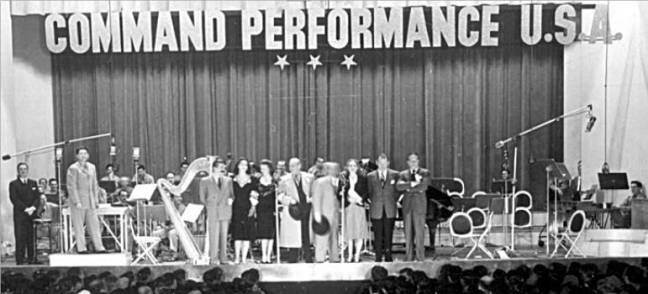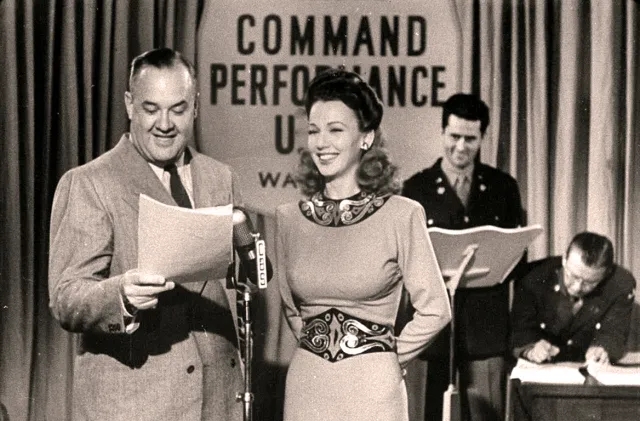
The Second World War has been referred to as “a radio war,” simply because radio was such an integral part of relaying information to the public about bond drives, rationing, the latest news, and other aspects of living on the home front, but radio was probably the most special for Americans on the frontlines. Imagine you’re a soldier, sailor, or airman fighting the war at the back of beyond. You haven’t seen your family, or possibly even a woman, for weeks or months. Home feels so far away, it might as well be on another planet.
Or is it? Servicepeople out in the fields were treated to a variety of radio shows created just for them by the Hollywood entertainment industry, who were happy to donate their time and talents, and during the war the Armed Forces Radio Services, or AFRS, was founded. While shows were broadcast live on shortwave, there were places where shortwave signals were inadequate, so in that case shows were recorded on special records and shipped directly to the forces to be played at various outposts.

Not only that, but certain radio shows such as Fibber McGee and Molly were also broadcast overseas for the servicemen for the duration of the war, a gesture that was no doubt much appreciated. Still, there was something about wartime shows, which are a remarkable snapshot of forties culture and what Americans who were off fighting thought about and missed. Naturally, the tireless Bob Hope was the patron saint of many AFRS programs, but we’ve kind of already talked about him. A little bit, anyway. Anywhoo…
While there’s no way to adequately cover everything the AFRS broadcast during the war, here are some of the most memorable of those shows, starting with…
Mail Call
While Mail Call was initially meant to give American servicepeople news from home, it didn’t stay that way. As Lt. Thomas A.H. Lewis said, “The initial production of the Armed Forces Radio Service was ‘Mail Call,’ a morale-building half hour which brought famed performers to the microphone to sing and gag in the best American manner.” Listen to some of the programs here.
Everything For the Boys
One of the war’s lesser-known shows, Everything For the Boys paired Ronald Colman with Arch Oboler, and the episodes were often retellings of Oboler’s radio plays, including an early version of “The House I Live In.” However, one of the real draws of the show was that it allowed servicepeople a way to call home, sometimes leading to on-air reunions. It was also one of the only servicepeople-oriented shows that were simultaneously broadcast to civilians in the United States. The show isn’t as well-archived as its contemporaries, but some episodes can still be found today (Listen to a selection here).
Strictly G.I.
Strictly G.I. was a request show, but seemed to be a little less crowded than others in terms of the faces who came and went every week. Hosted by Kay Kyser, Hollywood stars such as Linda Darnell and Lucille Ball took turns as “Letter Editors,” reading letters from servicemen and women on the air. Also in this particular clip, Lucille Ball assists Mel Blanc as he intones some rather familiar voices.
G.I. Jive

Originally planned as a DJ show that took requests, G.I. Jive really took off when OWI employee Martha Wilkerson, or “G.I. Jill” took the helm. Wilkerson was not a professional radio actor, but the servicemen loved her normalcy, and a quarter of the fan mail received by AFRS was addressed to her. G.I. Jill was broadcast six days a week on short wave. Listen to some of the shows here.
Jubilee
Unfortunately, even radio programs were segregated during the forties, and black Americans had their own radio program on AFRS called Jubilee. Hosted by Ernie “Bubbles” Whitman, Jubilee was also a request show, featuring patter and music from plenty of top-notch talent, playing to both black and white audiences, who didn’t regard it as a “black” show. It was just great entertainment. Soapboxes were still a thing now and then, though, as the show sometimes made subtle commentary about life in America, namely that of the working class.
Command Performance

By far, the grand pumbah of World War Two AFRS shows was Command Performance. Like the other titles in the stable, it was a request program, and it started almost as soon as the United States entered the war, broadcasting its first show on March 1, 1942. Originally recorded at the Longacre Theater in New York City, the show was moved to Hollywood so it was easier for the Hollywood industry to contribute.
While Command Performance mostly featured music and patter from stars, it also featured random sounds, such as Carole Landis sighing or a baby cooing. One soldier even requested to hear his dog barking, and the production team made that happen by traveling to the man’s hometown just to record his dog.
Here is a filmed sample of Command Performance, hosted by Bob Hope and featuring Jerry Colonna, June Allyson, Gloria DeHaven, and Frances Langford:
Here’s another filmed sample, also hosted by Bob Hope, that features Judy Garland, Betty Hutton, Lana Turner and a succulent steak that was fried on air along with some onions:
One of the most fondly remembered Command Performance episodes is Dick Tracy In B-Flat, which was broadcast on February 15, 1945 and showcases an impressive array of telent:
Command Performance would also stage a massive hour-and-a-half long program on September 6, 1945 in honor of VJ Day, but that’s another topic for another day. (Find an archive of the show here).
Most of these wartime shows were very short-lived, but Jubilee and Command Performance outlasted the Second World War, producing shows until around 1953 and 1950, respectively, when they ended due to budget cuts. However, Command Performance was brought back for a thirty-fifth anniversary retrospective in 1977, as a testament to the tremendous boost it and other similar shows gave to American servicepeople during a very dark time in our world’s history.
My post for Virginie’s William Holden Blogathon will be up tomorrow. Thanks for reading, all, and I hope to see you then…
If you’re enjoying what you see on Taking Up Room, please subscribe to my Substack page, where you’ll find both free and paid subscriber-only reviews of mostly new and newish movies, documentaries, and shows. I publish every Wednesday and Saturday.
Bibliography
